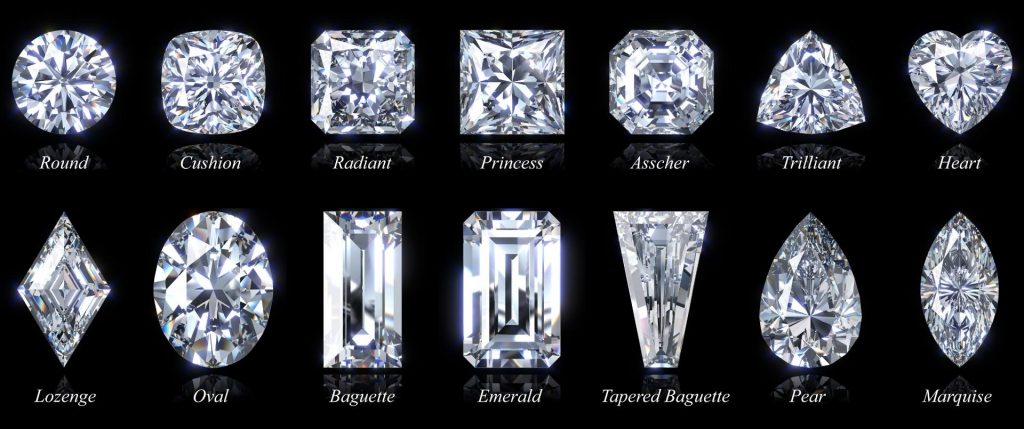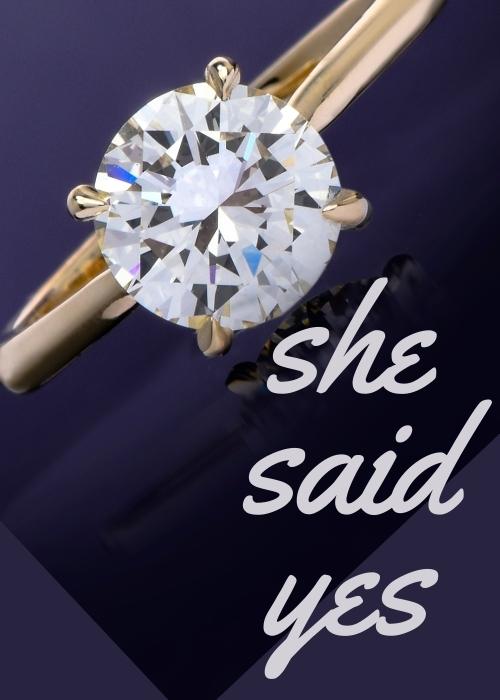Your search for the perfect diamond engagement ring can be stressful and confusing, so what do you need to know? Where to start?
1. Budget
How much should you spend? You may have heard the one, two or even three-month salary rule which suggests how much you “should” spend. This was introduced as a marketing ploy to encourage diamond sales. Feel free to totally ignore it! Your budget should be what you feel comfortable with. You’ll also find engagement ring calculators online, which calculate how much to spend based on your income, lifestyle and debt-to-asset ratio, which is a common-sense (though some may consider it unromantic) way to begin your life together.
You’ll want to weigh in the cost of the wedding and honeymoon, (if you are helping to cover these costs) and your partner’s expectations. Establish a budget – and stick with it. You’ll be glad you did later when unexpected bills pop up.
2. Stone
Should you choose a white or colored gemstone? This will be a question of personal preference, so ask yourself (or her, if she knows you are engagement ring shopping!) if you’d like something out of the ordinary – such as a yellow diamond, an emerald or a sapphire, perhaps. For more information about colored gemstones, please refer to our previous blog.
If you both have ultra-traditional tastes – and don’t want to rock the style boat too much – a brilliant-cut white diamond solitaire is always a safe bet.
3. Diamond Shape
Is the cut of your diamond or colored gemstone the same as its shape? This confuses many engagement ring newbies. Surely the diamond is cut into the shape you want, isn’t it?
Well, yes and no. The cut is created by a skilled jeweler to bring out the best characteristics of the shape to extract maximum brilliance. The diamond’s shape refers to its form– for example, round, square or pear-shaped. The cut refers to its proportions, symmetry, number of facets and its ability to reflect light. Shape and cutwork together to bring out the gemstone’s overall impact.
There are 10 main shapes from which to choose:
- Round – Usually “Brilliant” cut with 58 facets
- Princess – Square or moderately rectangular
- Cushion – Also known as the “Old Mine” cut and is cushion-shaped.
- Emerald – Flat surface, from nearly square to narrow rectangular, with chiseled step side.
- Oval – Unique twist on the round shape
- Asscher – Octagonal with squared-off edges.
- Pear – Elongated pear shape
- Radiant – Combination of the Round Brilliant and Emerald, with 70 facets
- Marquise – Football-shaped, elongated oval.
- Heart – Difficult to cut, expensive but oh, so appropriate!

4. Diamond Cut
Now that you have the shape you want, your diamond or gemstone’s cut will determine different levels of light reflection, which are fire, brilliance and scintillation. It’s the balance of these three types of light reflection that make a top-quality gemstone and determine its cost.
The GIA Diamond Cut Scale tells you how your stone measures up:
- Excellent: Representing the top 1% based on cut, polish and symmetry.
- Very Good: The top 3% in diamond quality. Proportions have led to some darkness.
- Good: The top 15% in diamond cut quality. Limited scintillation.
- Fair: The top 25% in terms of diamond cut quality. Lacking contrast and with general darkness.
- Poor: Represents diamonds that are cut too deep or too narrow and shallow, so they lose light.
5. Diamond Color
This is one of the famous 4Cs you’ve heard about, which are color, cut, clarity and carat weight. If you are buying a white diamond, it is the absence of color that is important. The GIA grades color as follows:
GIA Diamond Color Scale
- D: Totally colorless. Very rare and expensive.
- E. Considered colorless but has traces of color which can be detected by an expert. A high-quality diamond.
- F: Still considered colorless, but an expert can detect color traces. A high-quality diamond, nevertheless.
- G-H-I-J: Nearly colorless and still good value.
- K-L-M: Faintly tinted, usually yellow.
- N-O-P-Q-R: Lightly tinted in progressively darker tones of yellow. Color can be seen with the naked eye.
- S-T-U-V-W-X-Y-Z: Tinted, usually yellow, may progress to brownish. Visible to the naked eye.
6. Diamond Clarity
For your gemstone to sparkle, it needs to have a good clarity grade which should be as free of inclusions, blemishes and flaws as you can afford.
The GIA Diamond Clarity Scale is as follows:
- Flawless (FL) No inclusions and no blemishes visible under 10x magnification
- Internally Flawless (IF) No inclusions visible under 10x magnification
- Very, Very Slightly Included (VVS1 and VVS2) Inclusions so slight they are difficult for a skilled grader to see under 10x magnification
- Very Slightly Included (VS1 and VS2) Inclusions are observed with effort under 10x magnification but can be characterized as minor
- Slightly Included (SI1 and SI2) Inclusions are noticeable under 10x magnification
- Included (I1, I2, and I3) Inclusions are obvious under 10x magnification which may affect transparency and brilliance
7. Diamond Setting
Now let’s look at the type of setting. Again, it is a question of your style preference. There are many different types available, so we’ll focus on the most popular. Of course, you can choose a custom setting if you want something totally different, but remember, if you sell your ring in the future, it may not appeal to some buyers.
- Classic solitaire ring which features a single stone set with a four or six-prong mounting.
- Pavé rings are encrusted with multiple small diamonds to give the illusion of a solid diamond surface
- Channel set rings feature gemstones that are embedded within a channel in the band of the ring.
- Side-stone rings have a larger central diamond flanked by two or more smaller sized diamonds
- Three-stone rings feature a center stone (which could be a colored gemstone), flanked by two side stones.
- Tension set rings are contemporary in style and feature a diamond held in place by the tension of the ring, so that it appears to be floating in air.
- Halo engagement ring settings feature a center gemstone surrounded by smaller pavé diamonds
- Vintage/antique engagement ring. If your fiancée is a fan of Victorian, vintage or antique styles, there are plenty of engagement ring options. Vintage-style engagement rings can come in yellow gold, rose gold, white gold and platinum settings and many have colored gemstones in addition to diamonds.
8. Precious Metals
Finally, you will need to decide which precious metal to choose because it may dramatically alter the final look of the ring.
Here are your main options:
- 14K White Gold – 58.3% gold/41.7% alloys, complement diamonds well
- 18K White Gold – 75% gold, white color complements diamonds well
- 14K Yellow Gold – 58.3% gold/41.7% alloys, strong, long-wearing, easy to polish & repair
- 18K Yellow Gold – 75% gold/25% alloys, softer, more malleable metal, easy to repair
- Platinum – strongest precious metal, the highest level of purity, hypoallergenic
- Palladium -similar to platinum, but less dense, therefore lighter. Corrosion-resistant, low maintenance
- Silver – Relatively low price, can cause tarnishing to the skin, soft metal that is easily scratched.
It’s a lot to take in, we know.
When all is said and done – If you’re still uncertain, reach out to us for a FREE engagement ring consultation with one of our GIA Graduate Gemologists and we’ll be happy to help you.
And, by the way, CONGRATULATIONS!



